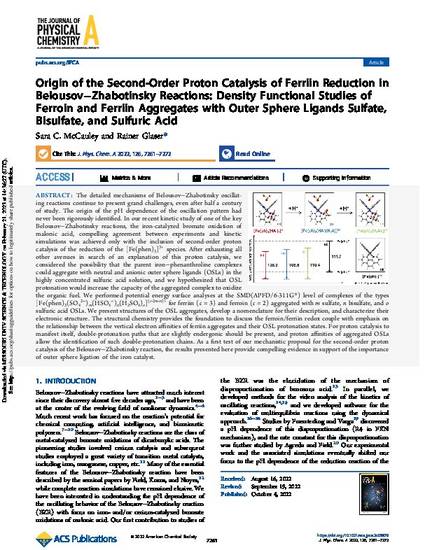
The detailed mechanisms of Belousov-Zhabotinsky oscillating reactions continue to present grand challenges, even after half a century of study. The origin of the pH dependence of the oscillation pattern had never been rigorously identified. In our recent kinetic study of one of the key Belousov-Zhabotinsky reactions, the iron-catalyzed bromate oxidation of malonic acid, compelling agreement between experiments and kinetic simulations was achieved only with the inclusion of second-order proton catalysis of the reduction of the [Fe(phen)3]3+ species. After exhausting all other avenues in search of an explanation of this proton catalysis, we considered the possibility that the parent iron-phenanthroline complexes could aggregate with neutral and anionic outer sphere ligands (OSLs) in the highly concentrated sulfuric acid solution, and we hypothesized that OSL protonation would increase the capacity of the aggregated complex to oxidize the organic fuel. We performed potential energy surface analyses at the SMD(APFD/6-311G*) level of complexes of the types [Fe(phen)3(SO42-)m(HSO4-)n(H2SO4)o](c-2m-n)+ for ferriin (c = 3) and ferroin (c = 2) aggregated with m sulfate, n bisulfate, and o sulfuric acid OSLs. We present structures of the OSL aggregates, develop a nomenclature for their description, and characterize their electronic structure. The structural chemistry provides the foundation to discuss the ferroin/ferriin redox couple with emphasis on the relationship between the vertical electron affinities of ferriin aggregates and their OSL protonation states. For proton catalysis to manifest itself, double-protonation paths that are slightly endergonic should be present, and proton affinities of aggregated OSLs allow the identification of such double-protonation chains. As a first test of our mechanistic proposal for the second-order proton catalysis of the Belousov-Zhabotinsky reaction, the results presented here provide compelling evidence in support of the importance of outer sphere ligation of the iron catalyst.
Available at: http://works.bepress.com/rainer-glaser/164/

National Science Foundation, Grant 1665487